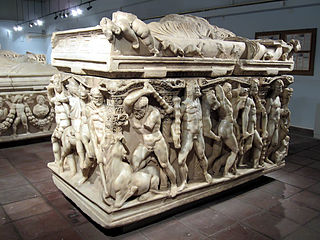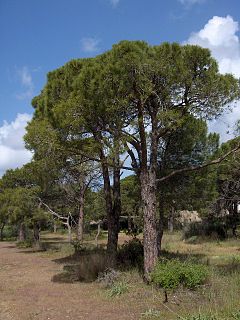
Alaşehir, in Antiquity and the Middle Ages known as Philadelphia, is a town and district of Manisa Province in the Aegean region of Turkey. It is situated in the valley of the Kuzuçay, at the foot of the Bozdağ Mountain. The town is connected to İzmir by a 105 km (65 mi) railway. The longtime mayor is Gökhan Karaçoban.

Comana was a city of Cappadocia and later Cataonia. The Hittite toponym Kummanni is considered likely to refer to Comana, but the identification is not considered proven. Its ruins are at the modern Turkish village of Şar, Tufanbeyli district, Adana Province.

Lyrbe was a city and episcopal see in the Roman province of Pamphylia Prima and is now a titular see.
Savatra, Sabatra, or Soatra was a city in the Roman province of Galatia, and subsequently the Byzantine province of Lycaonia.
Nyssa was a small town and bishopric in Cappadocia, Asia Minor. It is important in the history of Christianity due to being the see of the prominent 4th century bishop Gregory of Nyssa. Today, its name continues to be used as a titular see in the Eastern Orthodox Church and the Roman Catholic Church.

Tiberiopolis was a town in the Roman province of Phrygia Pacatiana, mentioned by Ptolemy, Socrates of Constantinople and Hierocles. At various times, it was considered as part of Phrygia, Isauria, and the late Roman province of Pisidia.
Basilinopolis or Basilinoupolis was a town in Bithynia Prima, which obtained the rank of a city under, or perhaps shortly before, Roman Emperor Julian the Apostate, whose mother was Basilina.
Temnos or Temnus was a small Greek polis (city-state) of ancient Aeolis, later incorporated in the Roman province of Asia, on the western coast of Anatolia. Its bishopric was a suffragan of Ephesus, the capital and metropolitan see of the province, and is included in the Catholic Church's list of titular sees.
Traianopolis, Trajanopolis, Tranopolis, or Tranupolis was a Roman and Byzantine city in Phrygia Pacatiana Prima.
Myrica or Myrika, also called Myrikion and Therma, was a city and bishopric in Galatia Salutaris, known for its hot springs.
Trapezopolis or Trapezoupolis (Τραπεζούπολις) was a city of ancient Caria, and later in the late Roman province of Phrygia Pacatiana Prima.

Perperene or Perperena was a city of ancient Mysia on the south-east of Adramyttium, in the neighbourhood of which there were copper mines and good vineyards. It was said by some to be the place in which Thucydides had died. Stephanus of Byzantium calls the town Parparum or Parparon (Παρπάρων), but he writes that some called the place Perine. Ptolemy calls it Perpere or Permere. According to the Suda, Hellanicus of Lesbos, a 5th-century BC Greek logographer, died at Perperene at age 85. At a later date it was given the name Theodosiopolis or Theodosioupolis (Θεοδοσιούπολις).
Carallia was a city of the Roman province of Pamphylia Prima and is mentioned in the acts of the Council of Ephesus (431). The same form of the name is given in the acts of the Council of Chalcedon (451).

Etenna was a city in the late Roman province of Pamphylia Prima. Centuries earlier, it was reckoned as belonging to Pisidia, as by Polybius, who wrote that in 218 BC the people of Etenna "who live in the highlands of Pisidia above Side" provided 8000 hoplites to assist the Seleucid usurper Achaeus.
Euaza, located in what is modern Turkey was a town during the Hellenic, Roman and Byzantine era. The town was in the upper portion of the Cayster River valley, about 100 km east from Ephesus. The town also known as Augaza, appears in Notitiea episcipum of the 9th century. The area is still mainly agricultural.

Isaura Palaea, in Latin Isaura Vetus, both meaning 'Old Isaura', and perhaps identical to Isauropolis, was a Roman and Byzantine era town in southern Turkey. The city has been identified with modern Zengibar Kalesi near Konya.

Isaura Nea, in Latin Isaura Nova, both meaning 'New Isaura', was a town of the Roman and Byzantine era, so called in juxtaposition with the settlement of Isaura Palaea. It also bore the name Leontopolis, and in later days was included in the province of Lycaonia.
Maionia or Maeonia, was a city of the Hellenistic, Roman and Byzantine era located near the Hermos River, in ancient Lydia. Both Ramsay and Talbert tentatively identified the ancient polis with the modern village of Koula a village known for its carpet manufacture.

Isinda was a town of ancient Pisidia.

Cinna or Kinna was a town of ancient Galatia. It was also the seat of a bishop; no longer a residential see, it remains a titular see of the Roman Catholic Church.









